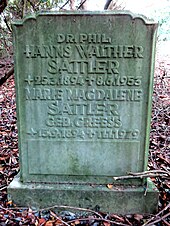Hanns Walther Sattler
Hanns Walther Sattler (born March 25, 1894 in Zedlitz , † June 8, 1953 in Hamburg ) was a German theater director .
Live and act
Born in the Trebnitz district , Sattler studied German philology at the University of Breslau immediately before and after the end of the First World War . He played theater for the first time at the city's United Theaters. In 1920 he received his doctorate on "The unpublished estate of Friedrich von Heyden". phil. He then played for several years on various provincial theaters. In 1923 he took over the management of the Koblenz City Theater . Two years later he switched to the Harburg Theater as artistic director , which he expanded into a two-part theater offering operas, operettas and drama.
In 1932, the city council of Harburg decided to re-privatize its previously urban stage. Sattler took over this theater and also leased the Schiller Theater in Altona , which he reopened as the Schiller Opera. In 1933 he left the Harburg stage again. He ran the Schiller Opera until 1939, when the building was needed for air raid purposes. Sattler then took over the Operettenhaus on Spielbudenplatz , which he successfully ran as the "Theater an der Reeperbahn" until August 1944.
As in Harburg, Sattler also offered German singspiel and game operas, well-known Italian and French operas and operettas, for which he hired prominent guest singers. He also campaigned for contemporary composers. In October 1932 he showed “Das kleine Mahagonny” by Kurt Weill and Bertolt Brecht and their “Lindberg Flight” for the first time in Hamburg . There were also premieres of short operas by Paul Hindemith and Ernst Krenek . Until the beginning of 1933, the socialist collective from Hamburg showed actors in the playhouse "The nail on the head" by Justin Steinfeld . In May 1933, the National Socialist guest theater from Berlin made a guest appearance here with “The Wanderer” by Joseph Goebbels .
Sattler worked in Hamburg with the unconventional director Benno Fränkel alias Benno Frank . The successful cooperation ended in 1933. He was replaced by the operetta buffo Josef Albrecht, who had been a member of the NSDAP since 1931 . Sattler, who was considered a Social Democrat and high-grade Freemason , joined the Stahlhelm in 1933 . So he managed to continue the theater with a greatly changed cast. Sattler offered a job to artists like Trude Possehl , who had played street theater for the SPD during the Weimar Republic . He also employed Erich Grandeit, a politically persecuted painter and set designer.
Until the 1934/35 season, Sattler could work artistically and entrepreneurially and show operettas by Jewish composers. After that he was subject to strict controls and was increasingly prohibited from performing operas. The repertoire was limited to entertainment pieces and individual guest appearances by well-known actors such as Hilde Hildebrandt and Johannes Heesters . In the field of operettas, Sattler was only allowed to offer pieces from the time of Johann Strauss or Franz Lehár , who developed into his most important composer. Lehár's last play Giuditta showed Sattler as a German premiere in January 1939.
After the end of the Second World War , Sattler reopened the theater, which had been destroyed a few months earlier, in October 1945 as the “Operettenhaus”. He initially used an auditorium at the Caspar-Voght-Straße school and in 1948 moved to the Palladium Theater, which moved into one of the halls of the trade union building on Besenbinderhof . In 1949 he set up the “Theater am Besenbinderhof” in the larger hall of the building, which, as he himself said, was to represent a “house of special events”. The theater opened with the play Gespenster with Albert Bassermann in the leading role. Prominent guest actors such as Gustaf Gründgens , Paul Kemp and Heinz Rühmann later appeared here .
Hanns Walther Sattler died of the consequences of a heart attack that he suffered during a press conference. His grave is on the Ohlsdorf cemetery , grid square AF 15 (west of Chapel 7).
literature
- Michaela Giesing: Sattler, Hanns Walther . In: Franklin Kopitzsch, Dirk Brietzke (Hrsg.): Hamburgische Biographie . tape 5 . Wallstein, Göttingen 2010, ISBN 978-3-8353-0640-0 , p. 319-320 .
Individual evidence
| personal data | |
|---|---|
| SURNAME | Sattler, Hanns Walther |
| BRIEF DESCRIPTION | German theater director |
| DATE OF BIRTH | March 25, 1894 |
| PLACE OF BIRTH | Zedlitz |
| DATE OF DEATH | June 8, 1953 |
| Place of death | Hamburg |
